Social Dynamics Simulation Using a Multi-Layer Network
Abstract
:1. Introduction
2. Materials and Methods
2.1. Description of Urban Space by Multi-Layer Network
2.1.1. Representation of Individuals, Households, and Urban Space
2.1.2. Representation of Individual Facility Access
- : Accessibility indicators by individual n.
- : Benefits obtained by individual n from choice j.
- : A choice set of individual n.
- : Variance parameter.
2.2. Network Dynamics Model
2.2.1. Basic Structure of Network Dynamics
2.2.2. Life Event Model
2.2.3. Transfer Household Generation Model
2.2.4. Location Choice Model
- , , : Parameters.
- : Zone attributes (distance from the city center, nearest station distance, etc.).
- : Synthetic accessibility of household h.
- : Land price.
- : Accessibility of individual in zone i.
- : Number of household h.
- : Individual categories of individual .
- : Individual categories in the analysis.
2.2.5. Land Price Model
- , , : Parameters.
- : Zone attributes (distance from the city center, nearest station distance, etc.).
- : Location density.
2.2.6. Transportation and Accessibility Model
- : Cost for link a, transport mode and individual category .
- : .
- : Public transport link by system l.
- : Ride time for road link a.
- : Ride time for public transport link .
- : Congestion for public transport link (hourly cost).
- : Operation frequency of system (considered only at the first public transport link).
- : Terminal charge of system for public transport link (considered only at the first public transport link).
- : Distance charge of system for public transport link .
- : Time value of individual category .
- : Customer attraction index of the facility (destination) .
- : ACC indicator between zone ij for individual category n.
- : Utilities between zone ij for individual category n.
- : Customer attraction index parameter.
- : Accessibility matrices parameter.
- : Generalized cost parameter.
- : Variance parameter.
- : Availability of transportation mode m for individual category n.
- : Status of transportation mode m for individual category n(available1, not available0, ride-sharing0–1).
- : Walkability, considering the walkable distance of the individual category (walking distance walkable distance1, walking distance walkable distance0).
- : Accessibility, considering the generalized cost threshold ( < , 0).
- : Free driving time of road link a.
- : Traffic capacity of road link a.
- : Parameter.
- : Traffic volume on public transportation link .
- : Capacity of public transportation system l.
- : Minimum operating frequency of public transportation system l.
- : Maximum operating frequency of public transportation system l.
- : Seating capacity of public transport system l.
- : Parameters.
- : Number of iterations.
- : Link traffic after the update ().
- : Link traffic before the update ().
- : Link traffic after redistribution in iteration .
- : Standardized accessibility indicators between zone ij for individual category n.
- : Accessibility index between zone ij of individual category n.
- : Minimum value of .
- : Maximum value of .
2.2.7. Interpretation of Facility Access Network
3. Results
3.1. Simulation Setting
3.2. Changes in Population and Number of Households
3.3. Changes in Traffic Condition
3.4. Facility Access Network Analysis
4. Discussion
4.1. Findings and Implications
4.2. Limitations
5. Conclusions
Author Contributions
Funding
Institutional Review Board Statement
Informed Consent Statement
Data Availability Statement
Conflicts of Interest
References
- Wegener, M. Overview of Land-Use Transport Model. In Proceedings of the CUPUM’03, Sendai, Japan, 27–29 May 2003. [Google Scholar]
- Wegener, M. Integrated land-use transport modelling progress around the globe. In Proceedings of the Fourth Oregon Symposium on Integrated Land-Use Transport Models, Portland, OR, USA, 15–17 November 2005. [Google Scholar]
- Waddell, P. UrbanSim: Modeling urban development for land use, transportation, and environmental planning. J. Am. Plan. Assoc. 2002, 68, 297–314. [Google Scholar] [CrossRef]
- Hunt, J.D.; Donnelly, R.; Abraham, J.E.; Batten, C.; Freedman, J.; Hicks, J.; Costinett, P.J.; Upton, W.J. Design of a statewide land use transport interaction model for Oregon. In Proceedings of the 9th World Conference on Transport Research, Seoul, Korea, 22–27 July 2001. [Google Scholar]
- Abraham, J.E.; Garry, G.R.; Hunt, J.D. The Sacramento Pecas model. In Proceedings of the Transportation Research Board Annual Meeting, Washington, DC, USA, 9–13 January 2005. [Google Scholar]
- Hunt, J.D.; Abraham, J.E. Pecas-for Spatial Economic Modelling: Theoretical Formulation; System Documentation Technical Memorandum 1 Working Draft; 2009. Available online: https://www.hbaspecto.com/resources/PECASTheoreticalFormulation.pdf (accessed on 2 December 2021).
- Salvini, P.; Miller, E.J. ILUTE: An operational prototype of a comprehensive microsimulation model of urban systems. Netw. Spat. Econ. 2005, 5, 217–234. [Google Scholar] [CrossRef]
- Moeckel, R.; Spiekermann, K.; Wegener, M. Creating a synthetic population. In Proceedings of the 8th International Conference on Computers in Urban Planning and Urban Management, Sendai, Japan, 27–29 May 2003. [Google Scholar]
- Strauch, D.; Moeckel, R.; Wegener, M.; Gräfe, J.; Mühlhans, H.; Rindsfüser, G.; Beckmann, K.J. Linking transport and land use planning: The microscopic dynamic simulation model ILUMASS. In Geodynamics; CRC Press: Boca Raton, FL, USA, 2005; pp. 295–311. [Google Scholar]
- Ettema, D.; de Jong, K.; Timmermans, H.; Bakema, A. PUMA: Multi-agent modelling of urban systems. In Modelling Land-Use Change; Springer: Berlin/Heidelberg, Germany, 2007; pp. 237–258. [Google Scholar]
- Chengxiang, Z.; Chunfu, S.; Jian, G.; Chunjiao, D.; Hui, Z. Agent-based joint model of residential location choice and real estate price for land use and transport model. Comput. Environ. Urban Syst. 2016, 57, 93–105. [Google Scholar]
- Newman, M.E.J. Networks; Oxford University Press: Oxford, UK, 2010. [Google Scholar]
- Wasserman, S.; Faust, K. Social Networks Analysis: Methods and Applications; Cambridge University Press: Cambridge, UK, 1994. [Google Scholar]
- Jamali, M.; Abolhassani, H. Different Aspects of Social Network Analysis. In Proceedings of the 2006 IEEE/WIC/ACM International Conference on Web Intelligence (WI 2006 Main Conference Proceedings) (WI’06), Hong Kong, China, 18–22 December 2006. [Google Scholar]
- Bavelas, A. A mathematical model for group structures. Appl. Anthropol. 1949, 7, 16–30. [Google Scholar] [CrossRef]
- Uchida, M.; Shirayama, S. Analysis of network structure and model estimation for SNS. J. Inf. Process. 2006, 47, 2840–2849. [Google Scholar]
- Tsugawa, S.; Ohsaki, H. Community structure and interaction locality in social networks. J. Inf. Process. 2015, 23, 402–410. [Google Scholar] [CrossRef] [Green Version]
- Mehmet, F.; Hakan, A.; Hakan, K.; Köksal, B. Determining open education related social media usage trends in Turkey using a holistic social network analysis. Educ. Sci. Theory Pract. 2017, 17, 1361–1382. [Google Scholar]
- Yie, K.-Y.; Chien, T.-W.; Yeh, Y.-T.; Chou, W.; Su, S.-B. Using Social Network Analysis to Identify Spatiotemporal Spread Patterns of COVID-19 around the World: Online Dashboard Development. Int. J. Environ. Res. Public Health 2021, 18, 2461. [Google Scholar] [CrossRef] [PubMed]
- Kim, E.-J.; Lim, J.-Y.; Kim, G.-M.; Kim, S.-K. Nursing Students’ Subjective Happiness: A Social Network Analysis. Int. J. Environ. Res. Public Health 2021, 18, 11612. [Google Scholar] [CrossRef] [PubMed]
- Camarasa, C.; Heiberger, R.; Hennes, L.; Jakob, M.; Ostermeyer, Y.; Rosado, L. Key Decision-Makers and Persuaders in the Selection of Energy-Efficient Technologies in EU Residential Buildings. Buildings 2020, 10, 70. [Google Scholar] [CrossRef] [Green Version]
- Maskil-Leitan, R.; Gurevich, U.; Reychav, I. BIM Management Measure for an Effective Green Building Project. Buildings 2020, 10, 147. [Google Scholar] [CrossRef]
- Senaratne, S.; Rodrigo, M.N.N.; Jin, X.; Perera, S. Current Trends and Future Directions in Knowledge Management in Construction Research Using Social Network Analysis. Buildings 2021, 11, 599. [Google Scholar] [CrossRef]
- Tamura, S.; Namerikawa, S.; Murakami, K.; Yamanaka, H.; Sawada, T.; Hanaoka, F. A study on monitoring method of the network between participatory process using by the social network analysis. Proc. Infrastruct. Plan. 2005, 32, 158_1–158_4. [Google Scholar]
- Gomyo, M. Study of remote islands networks by analogy with graph theory. J. Jpn. Soc. Civ. Eng. B3 2013, 69, I_604–I_609. [Google Scholar]
- Masuda, N.; Konno, N. Complex Network: From Basics to Applications; Kindai Kagaku Sha: Tokyo, Japan, 2010. [Google Scholar]
- Nakaminami, T.; Nakayama, S.; Kobayashi, S.; Yamaguchi, H. Vulnerability assessment of emergency transportation road networks based on eigenvalue analysis. J. Jpn. Soc. Civ. Eng. D3 2018, 74, I_1141–I_1148. [Google Scholar]
- Ando, H.; Kurauchi, F. Evaluation of road network investment by using network topology method. J. Jpn. Soc. Civ. Eng. D3 2020, 75, I_445–I_454. [Google Scholar] [CrossRef]
- Ando, H.; Michael, B.; Kurauchi, F.; Wong, K.I.; Cheung, K.F. Connectivity evaluation of large road network by capacity-weighted eigenvector centrality analysis. Transp. A Transp. Sci. 2021, 17, 648–674. [Google Scholar] [CrossRef]
- Kuwano, M. Study on the comparison of social network characteristics by population size. J. City Plan. Inst. Jpn. 2014, 49, 999–1004. [Google Scholar]
- Kuwano, M.; Fykuyama, K.; Inoue, W. A study on relationship between human ties and individuals’ security feeling based on social network analyseses. J. Jpn. Soc. Civ. Eng. D3 2016, 72, 415–422. [Google Scholar]
- Kuwano, M.; Fykuyama, K. An analysis of accessibility of life-related facilities considering social networks. J. Jpn. Soc. Civ. Eng. D3 2015, 71, 293–303. [Google Scholar]
- Guancen, W.; Jing, L.; Dan, C.; Xing, N. Analysis on the Housing Price Relationship Network of Large and Medium-Sized Cities in China Based on Gravity Model. Sustainability 2021, 13, 4071. [Google Scholar]
- He, S.; Mei, L.; Wang, L. The Dynamic Influence of High-Speed Rail on the Spatial Structure of Economic Networks and the Underlying Mechanisms in Northeastern China. Int. J. Geo-Inf. 2021, 10, 776. [Google Scholar] [CrossRef]
- Jiao, L.; Li, D.; Zhang, Y.; Zhu, Y.; Huo, X.; Wu, Y. Identification of the Key Influencing Factors of Urban Rail Transit Station Resilience against Disasters Caused by Rainstorms. Land 2021, 10, 1298. [Google Scholar] [CrossRef]
- Porta, S.; Crucitti, P.; Latora, V. Multiple centrality assessment in Parma: A network analysis of paths and open spaces. Urban Des. Int. 2008, 13, 41–50. [Google Scholar] [CrossRef] [Green Version]
- Kivelä, M.; Arenas, A.; Barthelemy, M.; Gleeson, J.P.; Moreno, Y.; Porter, M.A. Multilayer networks. J. Complex Netw. 2014, 2, 203–271. [Google Scholar] [CrossRef] [Green Version]
- Tanimoto, K.; Maki, S.; Kita, H. Accessibility measure for public transportation planning in rural areas. J. Jpn. Soc. Civ. Eng. D 2009, 65, 544–553. [Google Scholar] [CrossRef]
- Harata, N. Disaggregate Behavioral Model and Multidimensional Choice. Infrastruct. Plan. Rev. 1986, 4, 15–27. [Google Scholar] [CrossRef] [Green Version]
- Ben-Akiva, M.; Lerman, S.R. Discrete Choice Analysis; MIT Press: Cambridge, MA, USA, 1985. [Google Scholar]
- Sugiki, N.; Nagao, S.; Batzaya, M.; Suzuki, A.; Matsuo, K. Development of a household urban micro-simulation model (HUMS) using available open-data and urban policy evaluation. In Urban Informatics and Future Cities; The Urban Book Series; Springer: Berlin/Heidelberg, Germany, 2021; pp. 343–370. [Google Scholar]
- National Institute of Population and Social Security Research. The 15th Basic Survey on Birth Trends (National Survey on Marriage and Childbirth). Available online: https://www.ipss.go.jp/ps-doukou/j/doukou15/doukou15_gaiyo.asp (accessed on 2 December 2021).
- OECD Family Database. SF2.4: Share of Births Outside of Marriage. Available online: http://www.oecd.org/els/soc/SF_2_4_Share_births_outside_marriage.xlsx (accessed on 2 December 2021).
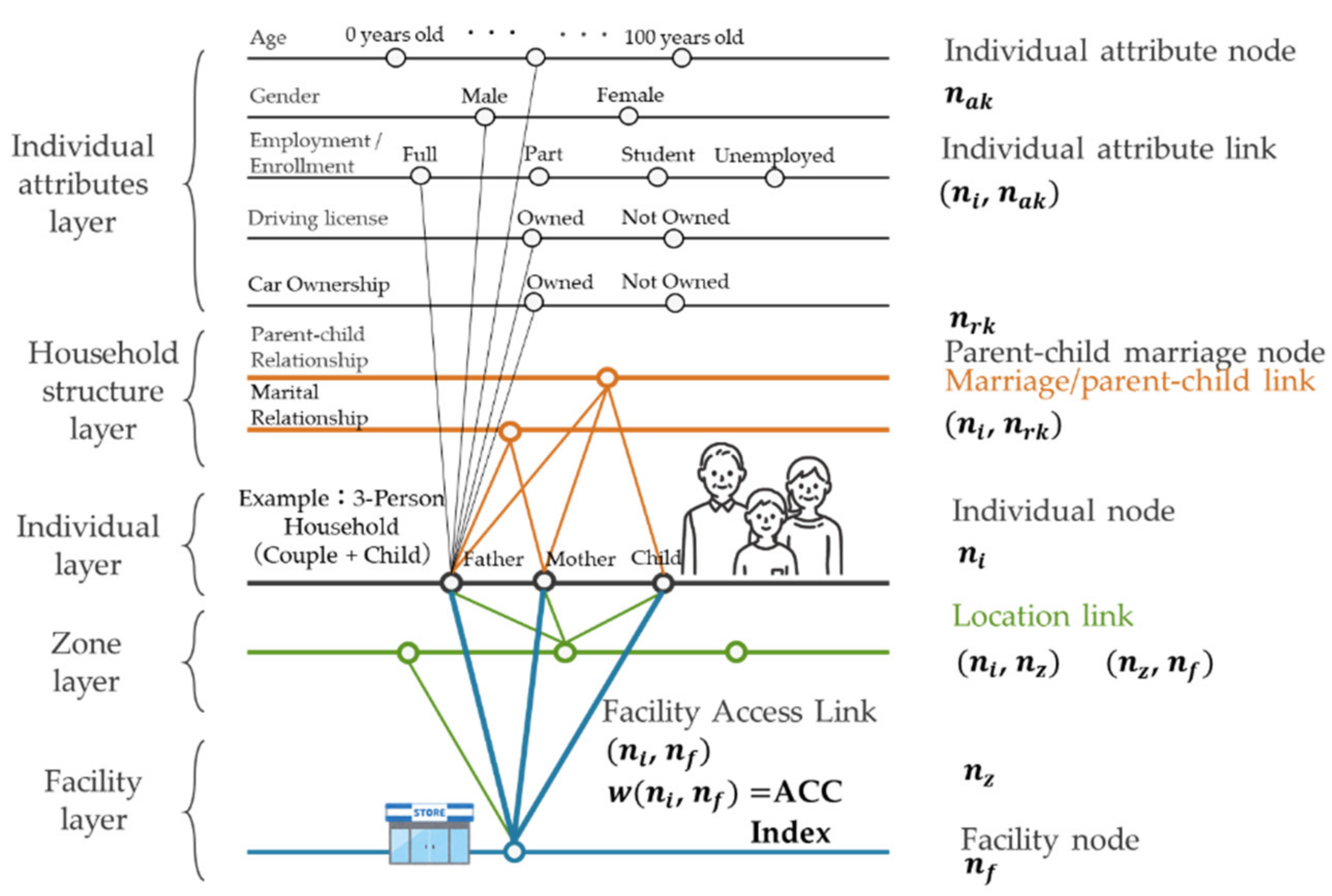
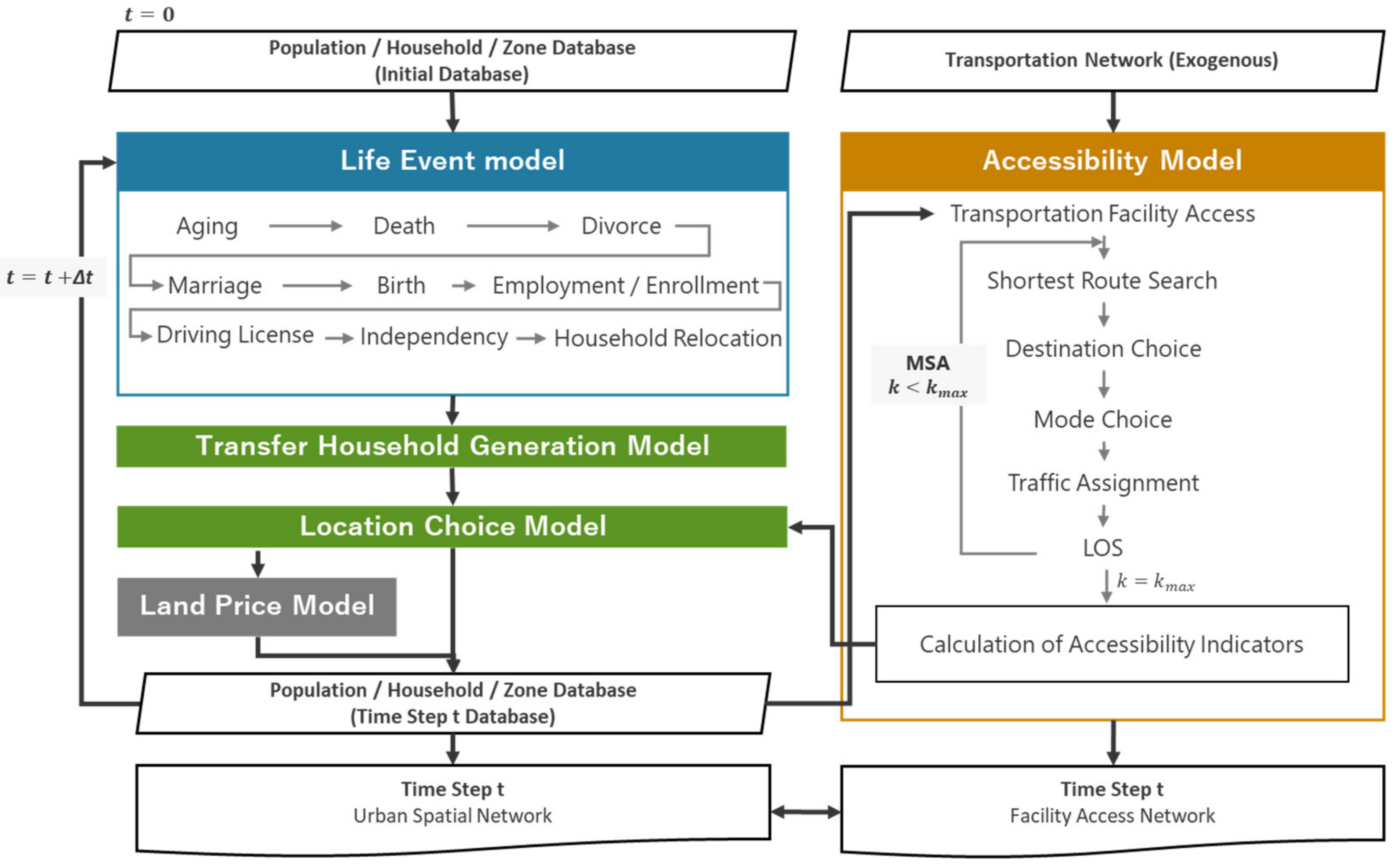
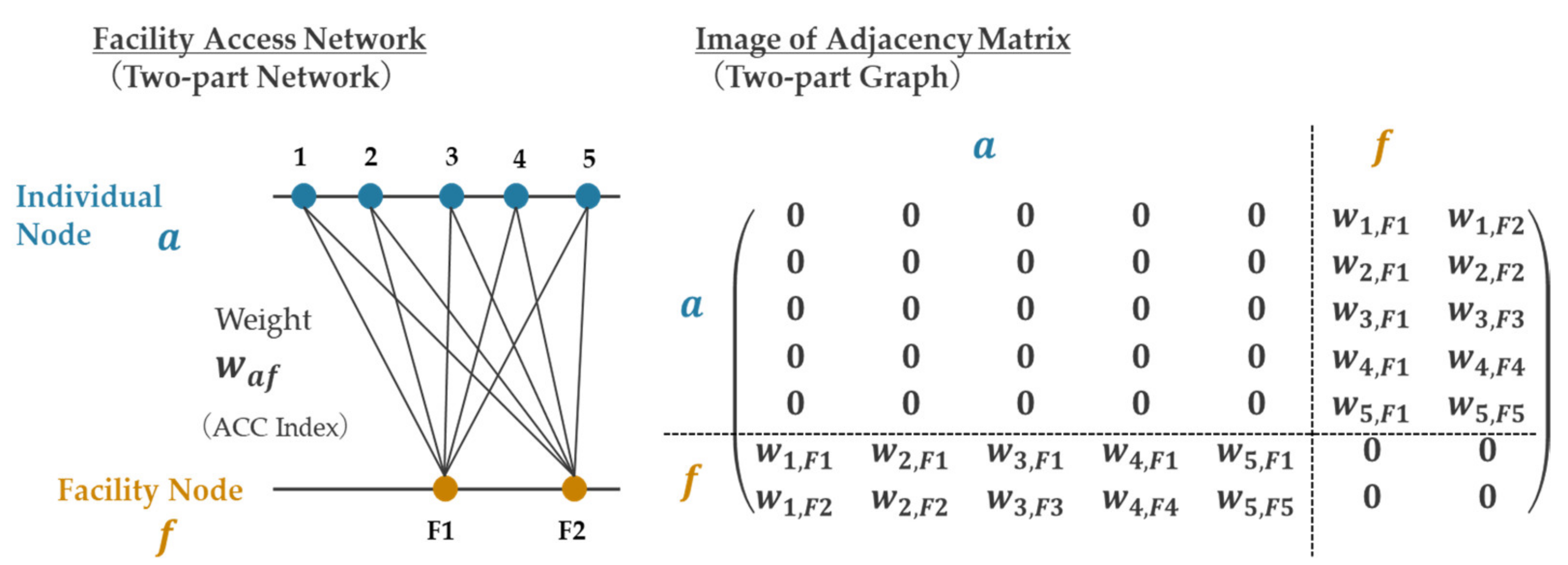


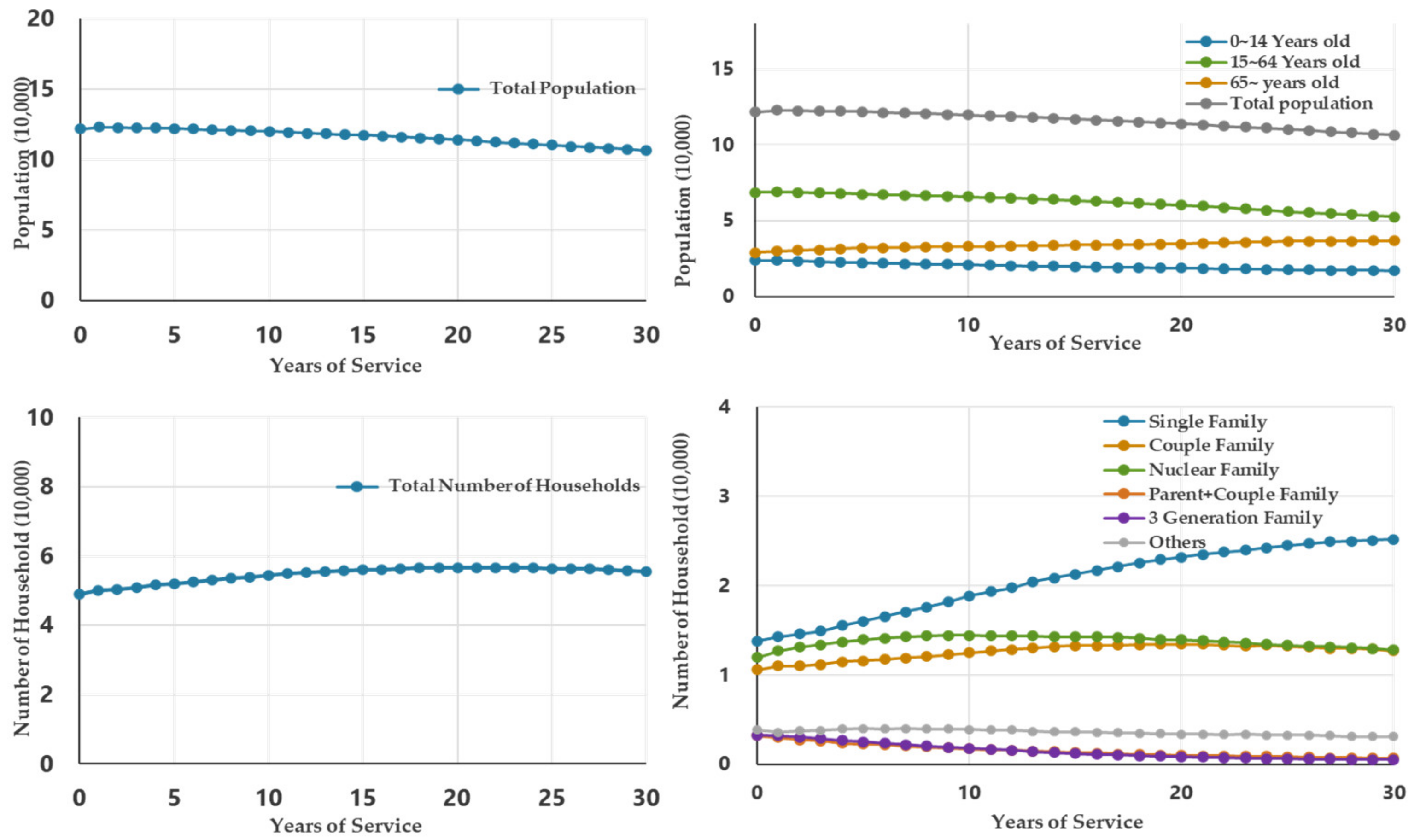




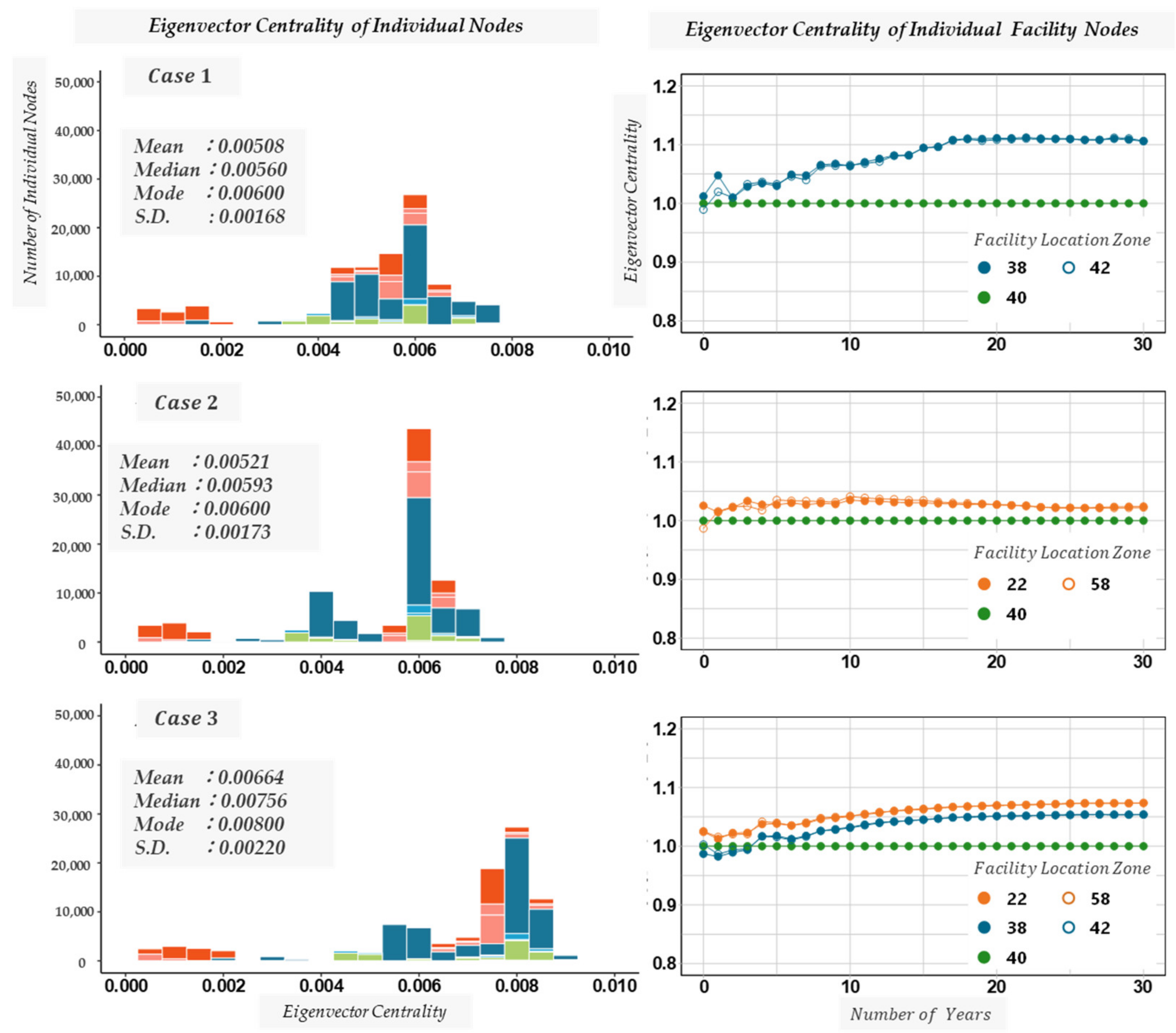
| Factors | Individual Node EC | Facility Node EC |
|---|---|---|
| Frequency | Number of Accessible Facilities | Number of Accessible Individuals |
| Weight | Individual Facility ACC Index | Individual Facility ACC Index |
| Adjacent Node EC | Facility Node EC Facility Accessibility | Individual Node EC Individual Accessibility |
| Individual Category n | Age | Availability of Transportation Mode | ||||||||
|---|---|---|---|---|---|---|---|---|---|---|
| Licensed | Driving | Public Transport | Walking | Riding | ||||||
 Elderly|Licensed Elderly|Licensed | 65– | 1 | 1 | 1 | 1 | 0 | ||||
 Non-Elderly|Licensed Non-Elderly|Licensed | 18–64 | 1 | 1 | 1 | 1 | 0 | ||||
 Elderly|No license (Shared) Elderly|No license (Shared) | 65– | 0 | 0 | 1 | 1 | 0.5 | ||||
 Elderly|No license (No Ride) Elderly|No license (No Ride) | 65– | 0 | 0 | 1 | 1 | 0 | ||||
 Non-Elderly|No license (Shared) Non-Elderly|No license (Shared) | 18–64 | 0 | 0 | 1 | 1 | 0.5 | ||||
 Non-Elderly|No license (No Ride) Non-Elderly|No license (No Ride) | 18–64 | 0 | 0 | 1 | 1 | 0 | ||||
 Child|No license (Shared) Child|No license (Shared) | 6–17 | 0 | 0 | 1 | 1 | 0.5 | ||||
 Child|No license (No Ride) Child|No license (No Ride) | 6–17 | 0 | 0 | 1 | 1 | 0 | ||||
| Individual Category n | Walking Speed | Walking Walkable Distance | Walking Time VoT | Waiting Time VoT | Ride Time VoT | Travel Cost Unit | Transfer Cost | Gen. Cost Parameter | Vehicle’s Constant Gen. Cost | |
| (km/h) | (km) | (Yen/Min) | (Yen/Min) | (Yen/Min) | (Yen/km) | (Yen/Times) | ||||
| Elderly|Licensed | 0 | 2.4 | 0.5 | 300 | 50 | 50 | 20.8 | 100 | −1 | 3000 |
| Non-Elderly|Licensed | 1 | 4.8 | 1.0 | 150 | 50 | 50 | 20.8 | 50 | −1 | 1500 |
| Elderly|Unlicensed (Shared) | 2 | 2.4 | 0.5 | 300 | 50 | 50 | 20.8 | 100 | −1 | 3000 |
| Elderly|Unlicensed (No Ride) | 3 | 2.4 | 0.5 | 300 | 50 | 50 | 20.8 | 100 | −1 | 3000 |
| Non-Elderly|Unlicensed (Shared) | 4 | 4.8 | 1.0 | 150 | 50 | 50 | 20.8 | 50 | −1 | 1500 |
| Non-Elderly|Unlicensed (No Ride) | 5 | 4.8 | 1.0 | 150 | 50 | 50 | 20.8 | 50 | −1 | 1500 |
| Child|Unlicensed (Shared) | 6 | 4.8 | 1.0 | 150 | 50 | 50 | 20.8 | 50 | −1 | 1500 |
| Child|Unlicensed (No Ride) | 7 | 4.8 | 1.0 | 150 | 50 | 50 | 20.8 | 50 | −1 | 1500 |
| (a) Traffic Network Conditions | ||||||||||
|---|---|---|---|---|---|---|---|---|---|---|
| Transport Mode | System | Capacity | Seat Capacity | Minimum Frequency | Maximum Frequency | Terminal Charges | Distance Cost | |||
| l | (Person/Mode) | (Person/Mode) | (Mode/Time) | (Mode/Time) | (Yen/Times) | (Yen/km) | ||||
| Train | East-West (Left and Right) | 200 | 100 | 2 | 10 | 100 | 20 | |||
| Bus | North-South (Top and Bottom) | 200 | 100 | 2 | 10 | 100 | 30 | |||
| Bus | Circulated | 60 | 30 | 2 | 10 | 100 | 30 | |||
| (b) Residential Location Choice Model | (c) Land Price Model | |||||||||
| Variables | Parameter | Variables | Parameter | |||||||
| Land Price (10,000 Yen) | −0.1 | City Center (Central Mesh)Distance (km) *Common Logarithm | −8.0 | |||||||
| City Center (Zone Centroid)Distance (km) *Common Logarithm | −0.2 | Nearest Station Distance (km) *Common Logarithm | −4.0 | |||||||
| Nearest Station Distance (km) *Common Logarithm | −0.4 | Population density = Population/Zone Area (Person/ha) | 0.1 | |||||||
| Household Synthetic ACC | 0.5 | Constant | 20 | |||||||
| (d) Facility(Destination)Unit Indicator | (e) Generalized Cost Threshold | |||||||||
| Facility Zone | Unit Indicator | Facility Zone | Unit Indicator | Transportation | Threshold (Yen) | |||||
| 22 | 500 | 42 | 500 | Private Vehicle | 1000 | |||||
| 38 | 500 | 58 | 500 | Car Riding | 1000 | |||||
| 40 (Central Zone) | 1500 | Public Transport | 3300 | |||||||
Publisher’s Note: MDPI stays neutral with regard to jurisdictional claims in published maps and institutional affiliations. |
© 2021 by the authors. Licensee MDPI, Basel, Switzerland. This article is an open access article distributed under the terms and conditions of the Creative Commons Attribution (CC BY) license (https://creativecommons.org/licenses/by/4.0/).
Share and Cite
Sugiki, N.; Nagao, S.; Kurauchi, F.; Mutahari, M.; Matsuo, K. Social Dynamics Simulation Using a Multi-Layer Network. Sustainability 2021, 13, 13744. https://doi.org/10.3390/su132413744
Sugiki N, Nagao S, Kurauchi F, Mutahari M, Matsuo K. Social Dynamics Simulation Using a Multi-Layer Network. Sustainability. 2021; 13(24):13744. https://doi.org/10.3390/su132413744
Chicago/Turabian StyleSugiki, Nao, Shogo Nagao, Fumitaka Kurauchi, Mustafa Mutahari, and Kojiro Matsuo. 2021. "Social Dynamics Simulation Using a Multi-Layer Network" Sustainability 13, no. 24: 13744. https://doi.org/10.3390/su132413744






